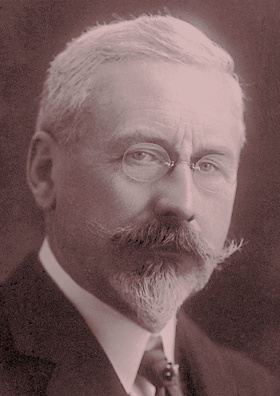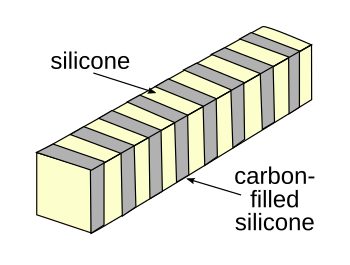Highly Flexible Conductors
February 13, 2017
Metals are excellent
conductors of electricity, and metal
wires are used as conductors for such varied applications as
high voltage transmission lines and the thin conductors in
integrated circuits.
Aluminum,
reinforced with steel, is an adequate conductor for power transmission, and aluminum was also the principal conductor in early integrated circuits. The
nanoscale conductors in today's high density integrated circuitry require a more conductive metal, so
copper is used. The transition from aluminum to copper was not that easy, since a complex
damascene process was required to form the
copper interconnects.
The dimensions of most
materials change with
temperature, one notable exception being the
alloy,
invar, the development of which secured the 1920
Nobel Prize in Physics for
Charles Édouard Guillaume. Copper and aluminum, for example, have very large
coefficients of thermal expansion, 17 and 23 ppm/°C, respectively.

Charles Édouard Guillaume (1861-1938)
One of his first publications estimated the temperature of space as 5.6 K; or, by his conversion, -267.4 °C.[1]
(Guillaume's official Nobel Prize portrait, via Wikimedia Commons, modified for artistic effect.)
The most common
printed circuit board material,
FR-4, has a
thermal expansion coefficient of about 13 ppm/°C, and
silicon has a thermal expansion coefficient of about 2.5 ppm/°C. Copper traces will shrink faster on these when the temperature is lowered, forcing the conductors to stretch. This is generally not a problem for integrated circuits and printed circuit boards, since these pure metals are highly
elastic; that is, they recover their shape after being stretched slightly.
However, the recoverable
elastic strain of metals and alloys is typically far less than a percent. What if we need an electrical conductor that will stretch or flex over a much larger range? There are special cases with exceptional elastic performance in metals. A 2011 study of the elastic strain limit of
single crystal nanowires of copper with a
diameter of about 6
nm showed a large recoverable strain as high as 7.2%.[2]
Elastic
composite materials are available if the electrical conductivity need not be as good as that of a metal. My first experience with such materials was an
elastomeric connector for attaching
OLED displays to a
test fixture. The elastomeric connector in that case was Zebra™ strip, a
carbon filled
silicone interleaved with unfilled silicone to make an assembly that conducts in just one direction (see figure). A variant of this concept has a sea of parallel wires embedded in the
elastomer.

Schematic of a Zebra™ strip elastomeric connector.
It can be seen that there is electrical conductivity in just one direction.
(Modified Wikimedia Commons image by Roland Mattern.)
The discovered high elasticity of copper nanowires of ref. 2 shows that nanoscale structures are a likely path to the development of flexible and stretchable conductors for such applications as
wearable electronic devices. In a recent article in
Science,
chemists and
engineers at
Stanford University (Stanford, California),
Nanjing University (Nanjing, China), the
SLAC National Accelerator Laboratory (Menlo Park, CA),
Gyeongsang National University (Jinju, South Korea), the
Hong Kong University of Science and Technology (Kowloon, Hong Kong), and the
Samsung Advanced Institute of Technology Yeongtong-gu (Gyeonggi-do, South Korea), have reported on their creation of highly stretchable
polymers in which
semiconducting polymer nanofibrils are contained in a soft elastomer.
The
researchers have named this
conjugated-polymer/elastomer
phase-separated material CONPHINE.[4] The material has a conductive phase of a conjugated polymer of DPPT-TT composed of repeating unit alternating
single and
double bonds embedded in an elastomer matrix of SEBS (see figure).[3]

Monomer units of the polymers DPPT-TT and SEBS. (Drawn using Inkscape.)
The conductivity of the DPPT-TT arises from
delocalized π-electrons, and molecular nanofibrils a few tens of nanometers in length of this phase are confined to a spatial dimension less than 100 nm. The elongated geometry helps the
charge transport in a given direction.[3] Fabrication is uncomplicated, since it involves just mixing the two polymers. The components
self-assemble into the conductive structure.[3]
Because of the nanoconfinement, the
elastic modulus of the conjugated polymer is significantly reduced, and this delays the onset of
crack formation under
strain.[4] The CONPHINE material has a high charge carrier conductivity that approaches that of
amorphous silicon, even when stretched to twice their original length, which is 100% strain (see figure).[3] The research team has fabricated stretchable
transistors and a
skin-like,
finger-wearable,
driver circuit for a
light-emitting diode.[4]

Mobility vs strain for CONPHINE and thick film polymers.
(Graphed using Gnumeric from data in ref. 4.[4]

Mobility vs stretching cycles for CONPHINE and thick film polymers.
(Graphed using Gnumeric from data in ref. 4.[4]
![]()
References:
- Charles-Edouard Guillaume, "La Température de L'Espace (The Temperature of Space)," La Nature, vol. 24, 1896 (From Los Alamos National Laboratory, via archive.org).
- Y. Yue, P. Liu, Z. Zhang, X. Han, and E. Ma, "Approaching the theoretical elastic strain limit in copper nanowires," Nano Lett., vol. 11, no. 8 (August 10, 2011), pp. 3151-5, doi: 10.1021/nl201233u.
- Simone Napolitano, "Perspective - Flexible Electronics, Staying conductive in the stretch," Science, vol. 355, no. 6320 (January 6, 2017), pp. 24-25, DOI: 10.1126/science.aal4113.
- Jie Xu, Sihong Wang1, Ging-Ji Nathan Wang, Chenxin Zhu, Shaochuan Luo, Lihua Jin, Xiaodan Gu, Shucheng Chen, Vivian R. Feig, John W. F. To, Simon Rondeau-Gagné, Joonsuk Park, Bob C. Schroeder, Chien Lu, Jin Young Oh, Yanming Wang, Yun-Hi Kim, He Yan, Robert Sinclair, Dongshan Zhou, Gi Xue, Boris Murmann, Christian Linder, Wei Cai, Jeffery B.-H. Tok, Jong Won Chung, and Zhenan Bao, "Highly stretchable polymer semiconductor films through the nanoconfinement effect," Science, vol. 355, no. 6320 (January 6, 2017), pp. 59-64, DOI: 10.1126/science.aah4496
Permanent Link to this article
Linked Keywords: Metal; electrical conductor; conductor of electricity; wire; overhead power line; high voltage transmission line; integrated circuit; aluminum; aluminium-conductor steel-reinforced cable; nanoscopic scale; nanoscale; copper; damascening; damascene; copper interconnect; material; temperature; alloy; invar; Nobel Prize in Physics; thermal expansion; coefficient of thermal expansion; Charles Édouard Guillaume (1861-1938); academic publishing; publication; outer space; kelvin; K; Celsius; °C; Nobel Prize; Wikimedia Commons; printed circuit board; FR-4; thermal expansion coefficient; silicon; elasticity; elastic; elastic strain; single crystal; nanowire; diameter; nanometer; nm; composite material; elastomeric connector; OLED display; test fixture; carbon; silicone rubber; electrical conductivity; wearable electronic device; Science; chemist; engineer; Stanford University (Stanford, California); Nanjing University (Nanjing, China); SLAC National Accelerator Laboratory (Menlo Park, CA); Gyeongsang National University (Jinju, South Korea); Hong Kong University of Science and Technology (Kowloon, Hong Kong); Samsung Advanced Institute of Technology Yeongtong-gu (Gyeonggi-do, South Korea); polymer; semiconductor; semiconducting; research; researcher; conjugated system; phase-separated; single bond; double bond; monomer; Inkscape; delocalized electron; pi bond; π-electron; charge carrier; charge transport; self-assembly; elastic modulus; fracture; crack formation; strain; amorphous silicon; transistor; skin; finger; driver circuit; light-emitting diode; electrical mobility; Gnumeric